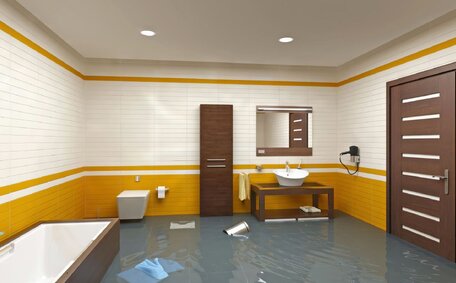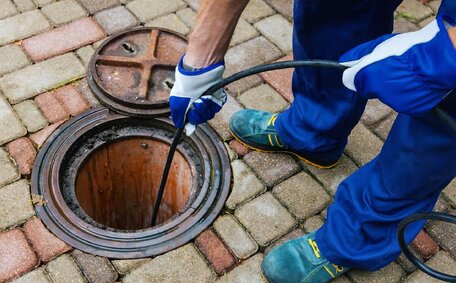How a Garbage Disposal Works
Installed under the kitchen sink, a garbage disposal unit grinds food scraps into small particles, preventing pipe clogs.
Upon activation, the unit draws a mix of food debris and water into the grinding chamber. Serrated edges on the spinning shredder plate keep running, breaking solid material into tiny pieces that are small enough to pass into garbage disposal plumbing without obstruction. The powerful motor and sharp edges allow it to pulverise most foods down as waste as it travels down garbage channels, including vegetable peels, egg shells and small bones.
Running cold water during use solidifies fats for easier grinding and disposal. Understanding the disposal interaction, including how clean garbage disposal should be, helps the waste travel smoothly down your drain, acting as a lubricant for the spinning shredder plate. Continue running water for 30 seconds after turning off the disposal to clear any residual particles.
This also prevents overheating and minimises odours.
Regular cleaning ensures efficient food breakdown and prevents pipe blockages. Neglecting basic upkeep tasks can lead to clogging, corrosion, and garbage disposal can emit foul smells.
Preventative Maintenance Tips
For efficient system operation, follow these maintenance steps:
Clean Every 2 Weeks
Remove the rubber splash guard and use an old toothbrush with dish soap to clean away grease and food residue. Scrub with dish soap, rinse well, and replace the splash guard.
Freshen with Ice and Salt
Every fortnight, grind two cups of ice with 1/2 cup of rock salt to keep your disposal in top shape. The salt and ice mixture can turn the inside of the unit into a clean space by knocking free any trapped food particles, with the salt acting as an abrasive cleaner.
Deep Clean Monthly
For deep cleaning, pour 1 cup baking soda and 1 cup white vinegar into the disposal and run it. Cover the disposal for a minute during the fizzing reaction, then run with water to rinse.
Avoid Fibrous Foods
Avoid disposing of stringy items like corn husks or celery, as they can entangle the blades and cause jams.
Effective maintenance ensures smooth food waste disposal for the long term.
Avoid Putting These Items Down the Disposal
Prevent damage, clogs, and odours by not disposing of these items:
- Eggshells - can cause them to get lodged around blades
- Coffee Grounds - Causes bad smells
- Potato Peels - Quickly causes obstructions
- Grease/Oils - Coats pipes leading to blockages
You should never put fibrous vegetable waste like artichokes, corn husks and celery down as they can tangle around the shredder plate. Always put food scraps in the bin rather than having to run garbage through the disposal.
Best Practices for Daily Use
If you learn how to properly use your garbage disposal unit as it’s designed on a daily basis, you will help avoid many issues down the line. Follow these guidelines when operating your unit:
- Ensure cold water is running while the unit is on and continue for 30 seconds after switching it off. Cold water hardens fats to prevent buildup and flushes particles with water down drain.
- Turn cold water on first to prime the chamber, then run the disposal for more than just a few seconds to ensure thorough grinding. Leave water running the entire time the unit is operating.
- Don’t grind too much food waste at once, process it in small batches with running water. Don’t overpack the chamber regardless of what put into the unit.
- Let the disposal once run for a full 60 seconds to get rid of all waste after each use.
- To remove large objects, always use tongs instead of your hands, even when the disposal is off.
- Refrain from disposing of starchy foods like rice or pasta, which can expand and lead to clogs.
Good habits are key to the daily upkeep of your garbage disposal.
Troubleshooting Common Issues
Some common issues with garbage disposals include unpleasant smells, leaking water, loud noises or failure to grind properly. Here are essential tips how to maintain and troubleshoot common disposal problems:
Persistent Odours
Clean and freshen your disposal by grinding 1/2 cup baking soda and 1/2 cup salt. Then, pour 1 cup of vinegar followed by 1 cup of boiling water down the drain for a thorough cleanse.
Leaking Water
Leaks typically come from a worn out seal. Turn off the power at the breaker box then check connections at the mounting assembly for tightness. Replace the unit if the seal is cracked.
Loud Noises
Squealing or rattling noises typically indicate a jam around the shredder plate. Use tongs to carefully remove debris. You can use certain hard items, but avoid bones or eggshells.
Poor Grinding
If grinding power decreases, worn blades or clogs may be to blame; try resetting the unit. Try the reset button underneath to restart the unit. If issues persist, the disposal may need servicing.
For severe clogs or repairs, seek a professional plumber to ensure your plumbing system works correctly.
Clearing Jams and Removing Debris
If your garbage disposal becomes jammed, follow these steps to safely clear out debris:
- Turn off to power your garbage disposal at the circuit breaker before attempting to clear any jams manually.
- Affix a flashlight to illuminate the inside of the disposal chamber.
- Use a pair of tongs or needle-nose pliers to gently grip and dislodge trapped food items. Avoid using your hands.
- Try twisting a half lemon peel to help scrub off stuck-on waste from the blades your disposal has.
- Once cleared, run cold water and run disposal to confirm it is running smoothly again.
- If jams persist, unplug the unit and inspect the chamber walls, shredding ring and drain outlet for obstructions.
Prevent future clogs and keep your unit in top condition by cleaning once every few weeks and avoiding problematic scraps.
Cleaning and Freshening the Disposal
Cleaning your garbage disposal and keeping it smelling fresh doesn’t require harsh chemicals. Here are some simple, natural methods to freshen it up:
Baking Soda and Vinegar
Pour 1 cup of baking soda into the drain, then add 1 cup of vinegar for a natural cleaning reaction. Wait for the solution to bubble for 5 minutes, then rinse with cold water to refresh the disposal. The combination scrubs away grease and neutralises odours in garbage disposal units.
Lemon or Lime Peels
After juicing a lemon or lime, toss the leftover peels down the disposal while running water. Grinding citrus peels helps scrub the chamber with their natural oils, leaving a pleasant scent behind.
Ice and Salt
For a thorough disposal cleaning, grind up 2 cups of disposal ice cubes with 1/2 cup of rock salt. The ice scrubs the inside while the salt works as a gentle abrasive. Flush with water to rinse after 1 minute.
Use one of these methods weekly or bi-weekly to keep your kitchen disposal fresh and clog-free.
Maintaining the Splash Guard and Drain Pipe
The splash guard is the rubber disc surrounding the drain opening that prevents debris splashback while the disposal is operating. Over time, grease and food scraps can accumulate here, so it’s important to clean it routinely.
To clean the splash guard, adhere to the following procedure:
- Unplug the disposal and turn off the power from the circuit breaker.
- Twist and lift off the rubber splash guard.
- Use a scrub brush and a mild detergent or dish soap to gently scrub away any gunk or buildup.
- Rinse thoroughly with warm water.
- Replace and ensure the freshly cleaned guard come out spotless, then test your disposal.
Clogs can also occur along the discharge tube and drain line that connects to your sink. Once month, flush about two cups of baking soda mixed with hot water down the drain while running the disposal to clean the interior of pipes.
When to Call a Professional Plumber
As a homeowner, maintaining your garbage disposal with regular cleaning and preventative care can prevent many issues. However, some problems may require a professional plumber for proper diagnosis and repair.
Follow these signs that indicate your disposal may need clean servicing from a qualified technician:
- Frequent jams that lessen your unit’s efficiency
- Persistent bad odours, even after cleaning
- Leaking water from the mounting assembly
- Loud grinding or rattling noises during operation
- Failure to start with reset button pressed
For fast and reliable plumbing assistance, contact the experts at Cherrybrook Plumbing, providing your name email and details of the issue. Reach out to our friendly staff at [email protected] or 1300 349 338.
As a local Sydney plumbing company, we can troubleshoot any garbage disposal problem and perform repairs or full unit replacements if needed.






